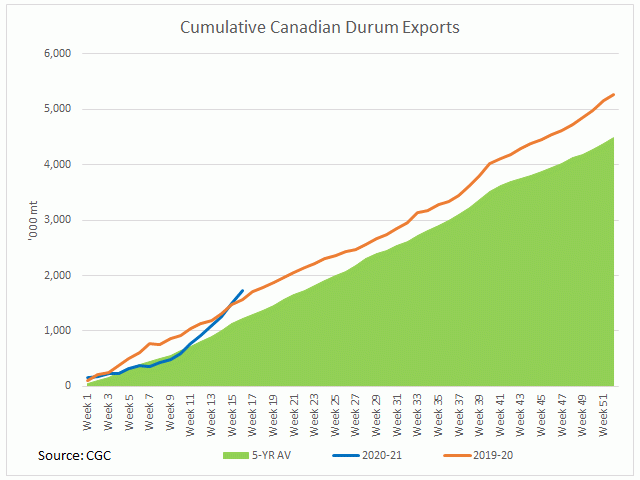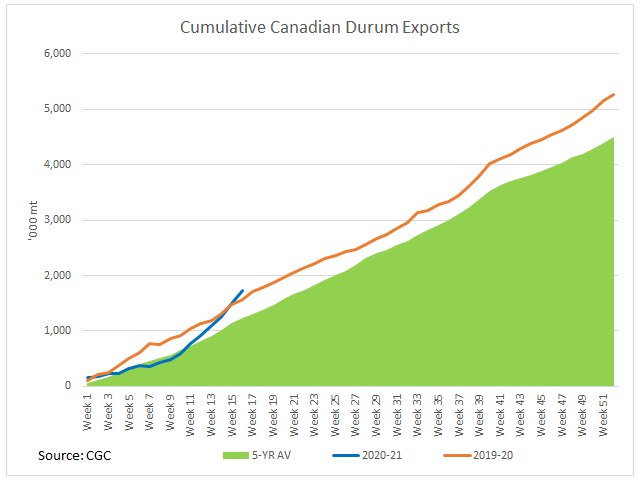Canada Markets
Canada's Durum Continues to Move
There have been numerous pieces written in 2020 on the "global pasta binge" taking place, with lockdowns around the world leading to changes in the way meals are prepared with noticeable effects on global commodity markets.
Forecasting this trend is challenging, if not impossible. At the same time, current government forecasts seem cautious while overlooking the demand that recent weeks have shown.
Agriculture and Agri-Food Canada increased its forecast for Canadian durum exports by a modest 10,000 metric tons this month, to 5.310 million metric tons, while down from the record 5.324 mmt shipped in 2019-20. At the same time, domestic use was revised 10,000 mt lower, leaving ending stocks unchanged this month at 800,000 mt, or 8.5% higher than the previous crop year.
While Canada's domestic milling is not a large contributor to durum disappearance, this week's Statistics Canada milling data shows 21,000 mt of durum milled in October, up for a third month to the highest level in five months. Since the beginning of August or the 2020-21 crop year, an average of 20,000 mt/month has been milled, up 7.1% from the three-year average. The current durum grind is ahead of the steady pace needed to reach the current Agriculture and Agri-Food Canada forecast of 214,000 mt, which is actually down from the 216,000 mt milled on 2019-20.
P[L1] D[0x0] M[300x250] OOP[F] ADUNIT[] T[]
While durum exports started the crop year on a slower pace than last year, weekly exports have climbed in each of the past two weeks to 240,800 mt in week 16, the highest weekly volume shipped this crop year. This is the second straight week of exports above 200,000 mt and the highest weekly volume shipped since week 39 of the 2018-19 crop year. There has only been five weeks in the past five crop years where weekly exports have exceeded 200,000 mt.
As seen on the attached chart, cumulative exports as of week 16, or the week ending Nov. 22, are reported at 1.7277 mmt, up 10.9% from last crop year and 41% higher than the five-year average for this period.
This movement should not be unexpected. Week 12 commercial stocks were reported at 975,200 mt, up 55.4% from the same week in 2019-20. Buyers have not shied away from taking ownership. Week 16 commercial stocks are reported at 752,400 mt, falling for two consecutive weeks and for the third time in four weeks, but remain 6.7% higher than the five-year average.
Another interesting point in the government's recent data is the average producer price, which was left unchanged this month at $270/mt, which is also unchanged from 2019-20. When pdqinfo.ca data is considered, the 2019-20 cash bids reported for the southern Alberta region moved above $300/mt in the month of July, reaching a high of $305.48/mt, but stayed above $300/mt only briefly. Data for eastern Saskatchewan shows prices moving to the low $300's in May 2020 but again, stayed there only briefly.
This week's prices show two of the three major producing areas reported by pdqinfo above $300/mt, reaching a high of $305.13/mt in southern Alberta and a high of $300.86/mt in eastern Saskatchewan. As of Nov. 26, southwest Saskatchewan has reached a high of $298.17/mt. This comes at a time when producers have delivered 1.9444 mmt in the first 16 weeks of the crop year, up 44.9% from the five-year average and we are also nearing freeze-up on the eastern seaway. Durum remains in demand.
While no data is available on where durum is being shipped recently, European Union data shows 1.079 mmt imported as of Nov. 23, or the first 21 weeks of their crop year which started July 1. This volume is up 61% from the same period in 2019-20 and up 155.6% from 2018-19. Canada has supplied 68.6% of this volume and the U.S. has supplied 23.6%.
In other global news, Tunisia purchased 75,000 mt of optional origin durum this week. Canada has shipped Tunisia just over 200,000 mt in each of the past two crop years, according to CGC data.
Statistics Canada's final production estimates will be of particular interest to durum market watchers.
Cliff Jamieson can be reached at cliff.jamieson@dtn.com
Follow Cliff Jamieson on Twitter @Cliff Jamieson
(c) Copyright 2020 DTN, LLC. All rights reserved.






Comments
To comment, please Log In or Join our Community .